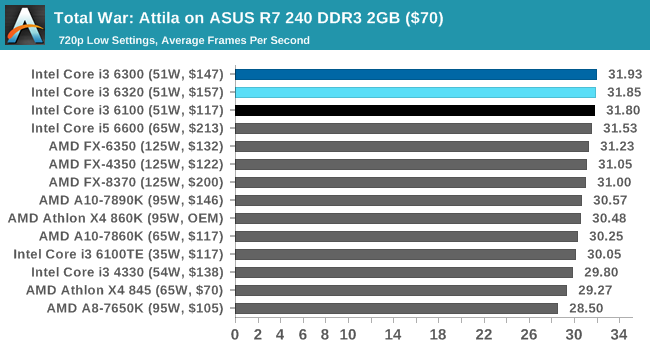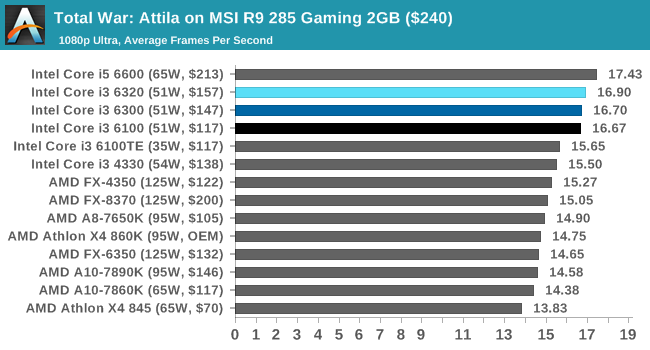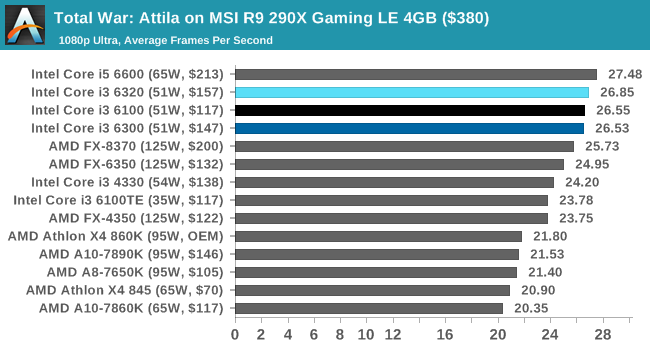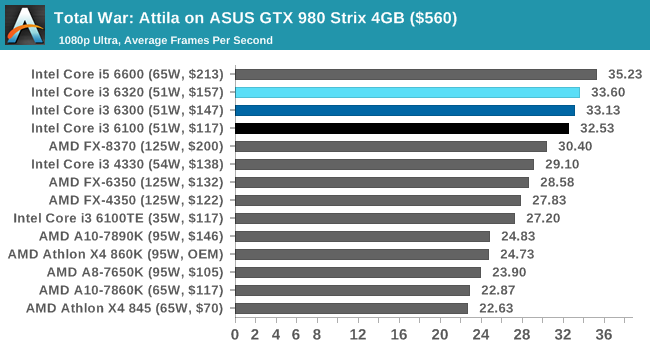The Skylake Core i3 (51W) CPU Review: i3-6320, i3-6300 and i3-6100 Tested
by Ian Cutress on August 8, 2016 9:00 AM ESTTotal War: Attila
The Total War franchise moves on to Attila, another The Creative Assembly development, and is a stand-alone strategy title set in 395AD where the main story line lets the gamer take control of the leader of the Huns in order to conquer parts of the world. Graphically the game can render hundreds/thousands of units on screen at once, all with their individual actions and can put some of the big cards to task. In our benchmark, the in-game scripted benchmark is used with the option for ‘unlimited video memory’ enabled.
For this test we used the following settings with our graphics cards:
| Total War: Attila Settings | |||
| Resolution | Quality | ||
| Low GPU | Integrated Graphics | 1280x720 | Performance |
| ASUS R7 240 1GB DDR3 | |||
| Medium GPU | MSI GTX 770 Lightning 2GB | 1920x1080 | Quality |
| MSI R9 285 Gaming 2G | |||
| High GPU | ASUS GTX 980 Strix 4GB | 1920x1080 | Quality |
| MSI R9 290X Gaming 4G | |||

For the integrated graphics, despite the difference between the APUs and Core parts, we can see the effect of 10% GPU frequency and a smaller L3 cache has on the i3-6100 (which has 3MB). The i3-6100TE is an oddball of the group, by actually having 4MB of L3 cache, which nudges it ahead of the regular i3-6100 by a small amout. Either way, the Intel GPUs aren't great for Attila gaming at 720p Low.





With the discrete graphics cards, the Core i3s again sit at the top or near the top in a regular staircase. Attila still seems to be a bit of a hog for frame rates at 1080p Ultra, barely scraping 30 FPS average on the GTX 980 with the Core i3 parts.











94 Comments
View All Comments
Samus - Tuesday, August 9, 2016 - link
^This.I love WinRAR, but even a blind test will demonstrate 7zip to be faster, especially at compression. Decompression is often storage limited unless you have a good RAID or PCIe SSD.
plopke - Monday, August 8, 2016 - link
I bought a core i3 6300 for my parents but only paid the price of a i3 6100 around 109 euro, the price gap is so big for such a small performance increase some vendors decided just to dump them out of their inventory.ShieTar - Monday, August 8, 2016 - link
Nice review. Any chance that the Pentiums and maybe even Celerons will be added to the comparison?Everybody reviews the i5&i7, but it's really hard to get any feel on how fast (or slow) the very cheapest Intel CPUs really are.
fanofanand - Tuesday, August 9, 2016 - link
I second this, I see a lot of inexpensive devices running low-end Intel parts and it sure would be nice to see how they stack up.jaydee - Monday, August 8, 2016 - link
Any attempts at trying Quicksync with the Skylake i3?AndrewJacksonZA - Wednesday, August 10, 2016 - link
+1 on the Quicksync please.elbert - Monday, August 8, 2016 - link
The i3's should have been removed from the desktop line up a long time ago. Quad cores come out over 10 years ago and Intel is still trying to sale dual cores for the desktop. Its really a testament to how tight a hold Intel's monopoly is on the PC business. Currently the hold that is killing the PC business.DanNeely - Monday, August 8, 2016 - link
The persistence of dual core hardware says more about the failure of most software to benefit from larger numbers of cores. Unless you've got at least 3 big threads running in parallel the extra physical cores of the i5/7 only serve to drive up manufacturing costs and power consumption.FunBunny2 - Monday, August 8, 2016 - link
-- The persistence of dual core hardware says more about the failure of most software to benefit from larger numbers of cores.the number of embarrassingly parallel user space applications continues to be stuck at a couple.
Ratman6161 - Monday, August 8, 2016 - link
But, for all those that are just web surfing, reading email, and typing Word documents, how much parallelism do they need? A while back I refurbished a couple of Core 2 duo laptops from about 2009. Upgraded them from 2GB to 4BB of cheap ram and slapped an el-cheapo SSD in place of the old 5400 RPM disk drives and they felt like new machines. For the people doing the sorts of tasks I mentioned above, they are more than good enough - even an i3 is overkill for the task.